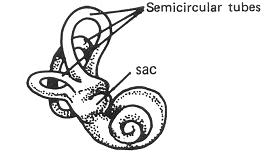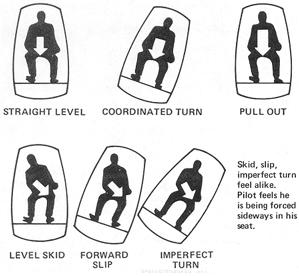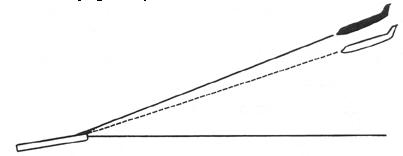
One purpose in instrument training and in maintaining instrument proficiency is to prevent us from being misled by several types of hazardous illusions that are peculiar to flight. In general an illusion or false impression occurs when information provided by our sensory organs is misinterpreted or inadequate. Many illusions in flight can be created by complex motions and certain visual scenes that we encounter under adverse weather conditions and at night. Some illusions may lead to spatial disorientation or the inability to determine accurately the attitude or motion of the aircraft in relation to the Earth's surface. Other illusions may lead to landing errors. Spatial disorientation as a result of continued VFR flight into adverse weather conditions is regularly near the top of the cause/factor list in annual statistics on fatal aircraft accidents. Knowledge, good judgment, and proficient instrument flying skills are needed to improve these statistics and help insure safe flying.
This chapter provides the basic knowledge we must have to understand the various illusions encountered in flight, to respect their serious consequences, and to enable us to cope with them effectively.
Sensory Systems for Orientation
We use three sensory systems for orientation: the visual system; the motion sensing system in the inner ear; and the position sensing system involving nerves in the skin, muscles, and joints. These systems work together so effectively when we are on the ground that we seldom have any difficulty with orientation.
Vision is obviously our major sensory organ for orientation while moving about on the ground and during VFR flight. Under VFR conditions, aircraft attitude can be determined by observing the Earth's surface, which usually provides accurate and believable visual information. However, under IFR conditions, aircraft attitude can only be determined accurately by observing and interpreting the flight instruments.
In the absence of reliable visual information from the Earth's surface, we become more aware of information provided by our motion and position sensing systems. Unfortunately, the sensations of motion and position during various flight maneuvers are often quite misleading, and even tend to compel us to believe them rather than information from the flight instruments.
Illusions Leading to Spatial Disorientation
The most hazardous illusions that lead to spatial disorientation are created by information received from our motion sensing system, located in each inner ear. As shown in Figure 2-1 this fluid-filled system consists of three semicircular tubes connected to a sac. Sensory organs in the tubes detect angular acceleration in the pitch, yaw, and roll axes, and a sensory organ in the sac detects gravity and linear acceleration. In flight, our motion sensing system may be stimulated by motion of the aircraft alone, or in combination with head and body movement. Unfortunately, the system is not capable of detecting a constant velocity or small changes in velocity (See Figure 2-1). Nor is it capable of distinguishing centrifugal force and gravity as shown in Figure 2-2. In addition, the motion sensing system, functioning normally in flight, can produce false sensations. For example, deceleration while turning in one direction can produce the sensation of turning in the opposite direction, an illusion which can be corrected only by overriding the sensations from the inner ear by adequate outside visual references or by proper reading of flight instruments.
The major illusions leading to spatial disorientation are:
"The leans" - A banked attitude, to the left for example, may be entered too slowly to set in motion the fluid in the "roll" semicircular tubes. An abrupt correction of this attitude can now set the fluid in motion and so create the illusion of a banked attitude to the right. The disoriented pilot may make the error of rolling the aircraft back into the original left-banked attitude or, if level flight is maintained, will feel compelled to lean to the left until this illusion subsides.
"Coriolis illusion" - An abrupt head movement made during a prolonged constant-rate turn may set the fluid in more than one semicircular tube in motion, creating the strong illusion of turning or accelerating, in an entirely different axis. The disoriented pilot may maneuver the aircraft into a dangerous attitude in an attempt to correct this illusory movement.
"Graveyard spin" - In a prolonged spin the fluid in the semicircular tubes which are in the axis of the spin will cease its motion (see Figure 2-1). The deceleration that occurs during recovery to level flight will again set this fluid in motion, creating an illusion of spinning in the opposite direction. The disoriented pilot may return the aircraft to its original spin.
"Graveyard spiral" - In a prolonged coordinated, constant-rate turn, the fluid in the semicircular tubes in the axis of the turn will cease its movement (see Figure 2-1). An observed loss of altitude in the aircraft instruments and the absence of any sensation of turning may create the illusion of being in a descent with the wings level. The disoriented pilot may pull back on the controls, tightening the spiral and increasing the loss of altitude.
"Somatogravic illusion" - A rapid acceleration during takeoff excessively stimulates the sensory organs for gravity and linear acceleration, and so creates the illusion of being in a nose-up attitude. The disoriented pilot may push the aircraft into a nose-low or dive attitude. A rapid deceleration by quick reduction of the throttle(s) can have the opposite the effect, with the disoriented pilot pulling the aircraft into a nose-up or stall attitude.
"Inversion illusion" - An abrupt change from climb to straight-and-level flight can excessively stimulate the sensory organs for gravity and linear acceleration, creating the illusion of tumbling backwards. The disoriented pilot may push the aircraft abruptly into a nose-low attitude, possibly intensifying this illusion.
"Elevator illusion" - An abrupt upward vertical acceleration, as can occur in a helicopter or an updraft, can shift vision downwards (visual scene moves upwards) through excessive stimulation of the sensory organs for gravity and linear acceleration, creating the illusion of being in a climb. The disoriented pilot may push the aircraft into a nose low attitude. An abrupt downward vertical acceleration, usually in a downdraft, has the opposite effect, with the disoriented pilot pulling the aircraft into a nose-up attitude.
"False horizon" - A sloping cloud formation, an obscured horizon, a dark scene spread with ground lights and stars, and certain geometric patterns of ground lights can provide inaccurate visual information for aligning the aircraft correctly with the actual horizon. The disoriented pilot may place the aircraft in a dangerous attitude.
"Autokinesis" - In the dark, a stationary light will appear to move about when stared at for many seconds. The disoriented pilot could lose control of the aircraft in attempting to align it with the false movements of this light.
Aircraft Maneuvers for Demonstrating Spatial Disorientation
There are a number of controlled aircraft maneuvers that an instructor pilot can perform to give a student pilot experience with spatial disorientation. Each maneuver will normally create a specific illusion. However, any false sensation is an effective demonstration of disorientation. Thus, should there be no sensation during any of these maneuvers, the absence of sensation is still an effective demonstration in that it shows inability to detect bank or roll.
Figure 2-1. Motion sensing system.
Our motion sensing system is located in each inner ear in the approximate position shown.
 |
Enlarged, this system is shaped about as shown. It contains fluid and the sensory organs for detecting angular acceleration, and gravity and linear acceleration.
 |
ANGULAR ACCELERATION
The semicircular tubes are arranged at approximately right angles
to each other, in the roll, pitch and yaw axes.
 |
A sensory organ, which consists of small sensory hairs that project into a gelantinous substance, is located in each tube. When the head starts to turn (angular acceleration), or speeds up, slows down, or stops its turning, the sensory hairs in the tube in the axis of turning are temporarily deflected due to the motion of the fluid lagging behind the motion of the tube wall. This causes the sensation of turning.
 |
 |
START OF TURN
Sensation of turning as moving fluid deflects hairs.
 |
CONSTANT RATE TURN
No sensation after fluid accelerates to same speed as tube wall
 |
TURN STOPPED
Sensation of turning in opposite direction as moving fluid deflects
hairs in opposite direction.
GRAVITY AND LINEAR ACCELERATION
A sensory organ for detecting gravity and linear acceleration is located
in the bottom and side of the sac. It consists of small sensory hairs that
project upward into a gelatinous substance containing chalk-like crystals.
The weight borne by these sensory hairs changes with every head movement
with respect to gravity and with every linear acceleration (up, down, left,
right, forward, backward), so causing the sensation of tilting the head
or body.
 |
 |
"Climbing While Accelerating" - With the student's eyes closed, the instructor maintains approach airspeed in a straight-and-level attitude for several seconds, and then accelerates while maintaining straight-and-level attitude. The usual illusion during this maneuver, without visual references, will be that the aircraft is climbing.
"Climbing While Turning" - With the student's eyes still closed and the aircraft in a straight-and-level attitude, the instructor pilot now executes, with a relatively slow entry, a well-coordinated turn of about 1 1/2 positive G for 90°. While in the turn, without outside visual references, and under the effect of the slight positive G, the usual illusion produced is that of a climb. Upon sensing the climb, the student should immediately open the eyes and see that a slowly-established, coordinated turn produces the same feeling as that of a climb.
"Diving While Turning" - This sensation can be created by repeating
the above procedure, with the exception that the student's eyes should
be kept closed until recovery from the turn is approximately one-half completed.
When the eyes are closed, the usual illusion will be that the aircraft
is diving.
"Tilting to Right or Left" - While in a straight-and-level-attitude,
with the student's eyes closed, the instructor executes a moderate or slight
skid to the left with wings level. The usual illusion is that the body
is being tilted to the right.
"Reversal of Motion" - This illusion can be demonstrated in any of the three planes of motion. While straight-and-level, with the student's eyes closed, the instructor smoothly and positively rolls the aircraft to approximately a 45° bank attitude while maintaining heading and pitch attitude. The usual illusion is a strong sense of rotation in the opposite direction. After this illusion is noted, the student should open the eyes and observe that the aircraft is in a banked attitude.
"Diving or Rolling Beyond the Vertical Plane" - This maneuver may produce extreme disorientation. While in straight-and-level flight, the student should sit normally, either with eyes closed or gaze lowered to the floor. The instructor starts a positive, coordinated roll toward a 30° or 40° angle of bank. As this is in progress, the student should tilt the head forward, look to the right or left, then immediately return the head to an upright position. The instructor should so time the maneuver that the roll is stopped just as the student returns the head upright. An intense disorientation is usually produced by this maneuver, with the student experiencing the sensation of falling downwards into the direction of the roll.
There are several objectives in demonstrating these various maneuvers.
(i) They indoctrinate student pilots in understanding the susceptibility
of the human system to spatial disorientation.
(ii) They demonstrate that judgments of aircraft attitude based
on bodily sensations are frequently false.
(iii) They can help to lessen the occurrence and degree of disorientation
through a better understanding of the relationship between aircraft motion,
head movements, and resulting disorientation.
(iv) They can help to instill a greater confidence in relying
on flight instruments for assessing true aircraft attitude.
None of these familiarization maneuvers should be attempted by a student pilot in the absence of an instructor pilot, or at low altitude.
How to Cope with Spatial Disorientation
We can take action to prevent these illusions and their potentially
disastrous consequences if we:
1. Always obtain preflight weather briefings.
2. Do not continue flight into adverse weather conditions or
into dusk or darkness unless proficient in the use of flight instruments.
3. Ensure that when outside visual references are used, they
are reliable, fixed points on the Earth's surface.
4. Avoid sudden head movements, particularly during takeoffs,
turns, and approaches to landing.
5. Remember that illness, medication, alcohol, fatigue, sleep
loss, and mild hypoxia are likely to increase susceptibility to spatial
disorientation.
6. Most importantly, become proficient in the use of flight
instruments and rely upon them.
The sensations which lead to illusions during instrument flight
conditions are normal perceptions experienced by normal individuals. These
undesirable sensations cannot be completely prevented, but they can and
must be ignored or sufficiently suppressed by developing absolute reliance
upon what the flight instruments are telling us about the attitude of our
aircraft.
Practice and experience in instrument flying are necessary to
aid us in discounting or overcoming false sensations. As additional proficiency
in instrument flying is acquired, we become less susceptible to these false
sensations and their effects.
Illusions Leading to Landing Errors
Of the senses, vision is the most important for safe flight. However, various surface features and atmospheric conditions encountered when landing can create illusions of incorrect height above, and distance from, the runway threshold. The major illusions leading to landing errors are:
"Runway width illusion" - A narrower-than-usual runway can create an illusion that the aircraft is at a higher altitude than it actually is (see Figure 2-3), especially when runway length-to-width relationships are comparable. The pilot who does not recognize this illusion will fly a lower approach, with the risk of striking objects along the approach path or landing short. A wider-than-usual runway can have the opposite effect, with the risk of leveling out high and landing hard or overshooting the runway.
"Runway and terrain slopes illusion" - An upsloping runway, upsloping terrain, or both, can create an illusion that the aircraft is at a higher altitude than it actually is (see Figure 2-4). The pilot who does not recognize this illusion will fly a lower approach. A downsloping runway, downsloping approach terrain, or both, can have the opposite effect.
"Featureless terrain illusion" - An absence of surrounding ground features, as when approaching over water, darkened areas, or terrain made featureless by snow, can create an illusion that the aircraft is at a higher altitude than it actually is. The pilot who does not recognize this illusion will fly a lower approach.
"Atmospheric illusions" - Rain on the windscreen can create an illusion of being at a higher altitude, while atmospheric haze can create an illusion of being at a greater distance from a runway. The pilot who does not recognize these illusions will fly a lower approach. Penetration of fog can create an illusion of pitching up. The pilot who does not recognize this illusion will steepen the approach, often quite abruptly.
"Ground lighting illusions" - Lights along a straight path, such as a road, and even lights on moving trains can be mistaken for runway and approach lights. Bright runway and approach lighting systems, especially where few lights illuminate the surrounding terrain, may create the illusion of less distance to the runway. The pilot who does not recognize this illusion will fly a higher approach.
How to Prevent Landing Errors From Visual Illusions
We can take action to prevent these illusions and their potentially
hazardous consequences if we:
1. Anticipate the possibility of visual illusions during approaches
to unfamiliar airports, particularly at night or in adverse weather conditions.
2. Conduct aerial visual inspection of unfamiliar airports before
landing.
3. Use the fixed and reliable VASI systems for a visual reference,
or an electronic glideslope, whenever they are available.
4. Recognize that the chances of being involved in an approach
accident are increased when some emergency or other activity distracts
from usual procedures.
5. Maintain optimum proficiency in landing procedures.
6. Most importantly, make frequent reference to the altimeter.
This instrument should be a primary aid during all approaches - day and
night.
 |
A wider-than-usual runway can create an illusion that the aircraft is lower than it actually is, leading to a higher approach.
 |
 |
A downsloping runway can create the illusion that the aircraft is lower than it actually is, leading to a higher approach.
 |